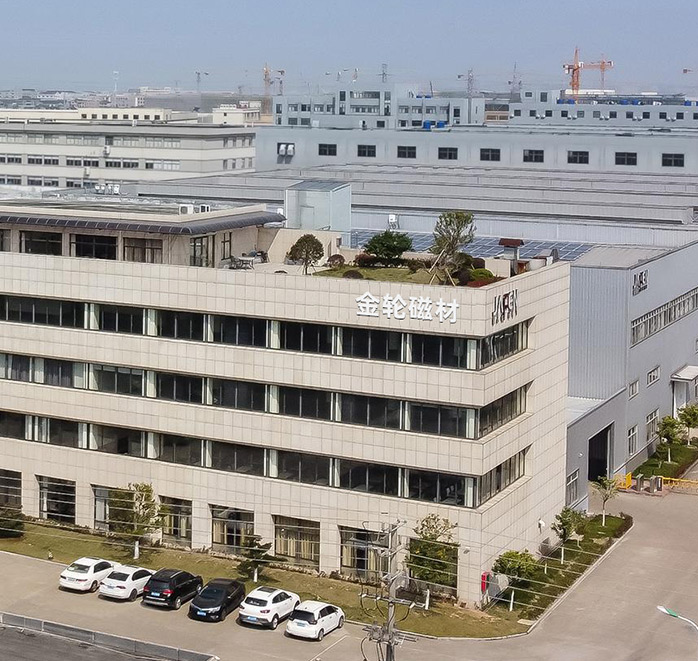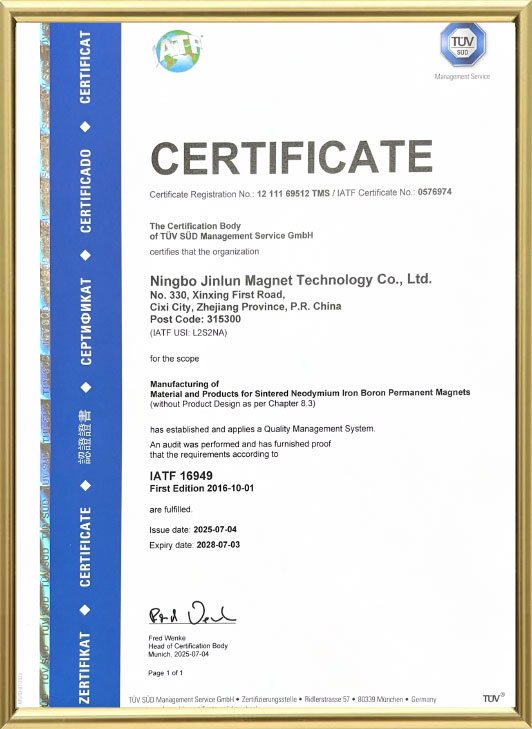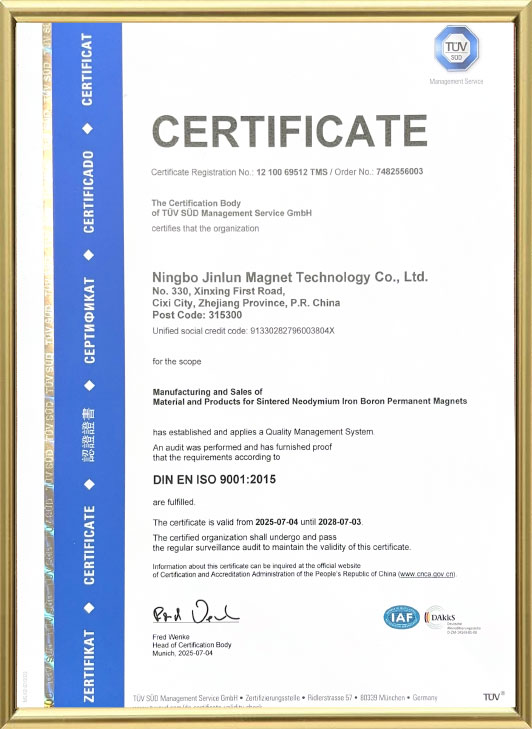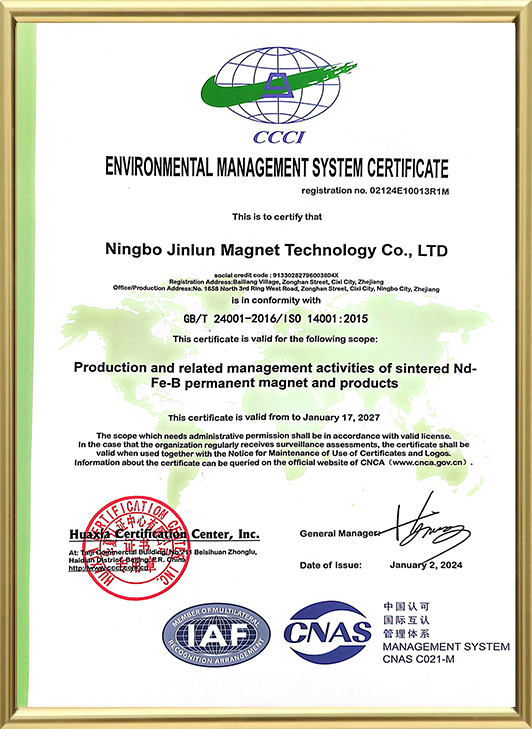I. Industry Positioning and Strategic Significance
Sintered NdFeB magnets for aerospace field a core and fundamental position in the modern aerospace industry, serving as a key material for achieving high efficiency, lightweighting, and intelligent aircraft. Their high magnetic energy product (BH) max reaching 350-450kJ/m³), high coercivity (Hcj ≥ 900kA/m), and stable magnetic properties have led to their widespread application in critical systems such as aircraft engines, satellite attitude control, and avionics equipment. By creating a precisely controllable magnetic field, they enable efficient conversion of electrical and mechanical energy, precise equipment control, and stable signal transmission. These magnets directly impact the performance and reliability of aerospace equipment, making them a strategic supporting material for high-end aerospace manufacturing.
II. Core Application Scenarios
(I) Aircraft Engine Systems
Starter Motor: During the start-up phase of an aircraft engine, sintered NdFeB magnets, as the core component of the starter motor, generate powerful starting torque (up 30% higher than traditional magnets), rapidly driving the engine rotor to ignition speed. For example, the C919's domestically produced engine starter motor utilizes high-performance sintered NdFeB magnets, reducing startup time to less than 5 seconds and ensuring reliable engine starting under various operating conditions.
Fuel pump motors: Magnets are used in the brushless DC motors of aircraft engine fuel pumps. Their stable magnetic field enables high-precision speed control (speed fluctuation ≤ 1%), precisely adjusting fuel injection volume, and improving engine combustion efficiency by 5%-8%, reducing fuel consumption and carbon emissions. (II) Aircraft Attitude Control Systems
Aircraft Flight Control: In the electric actuators of aircraft control surfaces such as ailerons, flaps, and rudders, sintered NdFeB magnets drive motors to achieve precise angle control (angle accuracy of ±0.1°) with a response time of less than 20ms. This ensures rapid and stable attitude adjustments during flight, improving flight safety and controllability.
Satellite Attitude Adjustment: For satellites, sintered NdFeB magnets in attitude control devices such as reaction flywheels and magnetic torquers interact with the Earth's magnetic field to generate precise control torque (torque accuracy of ±0.01 N·m), adjusting the satellite's attitude to maintain the correct orbital position and heading, ensuring the smooth progress of communication and remote sensing missions.
(III) Avionics Equipment
Sensors: In aircraft inertial navigation systems and atmospheric data sensors, sintered NdFeB magnets are used to generate high-precision magnetic fields. Combined with Hall elements and magnetoresistive elements, they enable precise measurement of aircraft parameters such as attitude, speed, and altitude, with measurement accuracy improved by 20% compared to traditional sensors. For example, the inertial navigation sensors on the Boeing 787 passenger aircraft utilize miniature sintered NdFeB magnets, achieving position measurement accuracy of ±0.1m and providing reliable data for the aircraft's autopilot.
Communications equipment: In satellite communications and the Aircraft Communications Addressing and Reporting System (ACARS), magnets are used in components such as RF transformers and filters. Stabilizing magnetic fields enables efficient signal coupling and filtering, improving communication quality and reducing signal interference and attenuation. For example, the International Space Station's communications system utilizes RF components incorporating sintered NdFeB magnets, ensuring stable communication with ground control centers and data transmission rates exceeding 10Mbps.
III. Key Performance Standards
(I) Extreme Environment Adaptability
High and Low Temperature Stability: Aerospace equipment operates over a wide temperature range, from low temperatures at high altitude (-60°C) to high engine temperatures (200°C). The sintered NdFeB magnets must have a remanence temperature coefficient (αBr) ≤ -0.12%/°C and an intrinsic coercivity temperature coefficient (βHcj) ≤ -0.6%/°C. After 100 hours at 200°C, the magnetic performance degradation rate must be ≤ 3%. At -60°C, the magnets must exhibit no brittle cracking and maintain stable magnetic properties, ensuring normal operation across the entire temperature range.
Radiation tolerance: Satellites are exposed to high-energy particle radiation in the space environment. Magnets must exhibit high radiation tolerance, with magnetic performance fluctuations ≤ 5% at a radiation dose of 1000 krad to prevent radiation-induced degradation that could impact satellite attitude control and communication capabilities.
High vacuum adaptability: Space is a high vacuum environment (vacuum ≤ 10⁻⁵Pa). Magnets must have a low outgassing rate (≤ 1×10⁻⁸Pa・L/(s・cm²)) to prevent volatile contamination of satellite optical and electronic components and ensure long-term stable operation. (II) High Reliability and Long Life
Mechanical Reliability: Magnets in aircraft engines and aircraft control systems must withstand mechanical stresses such as high rotational speeds (>10,000 rpm), high vibration (vibration acceleration ≥10g), and high impact (impact acceleration ≥100g). Magnets must have a bending strength ≥30 MPa and a compressive strength ≥1000 MPa, with no cracks or breakage after 1 million vibration cycles, ensuring reliable operation in complex mechanical environments.
Long-Life Design: Aerospace equipment has a long service life, with commercial aircraft having a lifespan of 20-30 years and satellites 5-15 years. Magnets must pass accelerated life testing to verify that the magnetic performance degradation rate is ≤10% after more than 10 years of operation under simulated service conditions, meeting the full lifecycle requirements of the equipment.
(III) Lightweighting and High Precision
Lightweighting: In the aerospace industry, every kg reduction in weight reduces fuel consumption and increases payload. Sintered NdFeB magnets are required to maintain a density of 7.4-7.6g/cm³ while maintaining high performance. Lightweight magnet design is achieved through optimized composition and process. For example, nanocrystal composite technology can be used to improve magnetic performance while reducing density by 5%-10%.
Dimensional Accuracy: Magnets used in avionics equipment and satellite precision instruments require extremely high dimensional accuracy. Dimensional tolerances must be controlled within ±0.005mm, and the curvature error for curved magnets must be ≤0.002mm. This ensures precise assembly with the equipment and prevents performance degradation due to dimensional deviations.
IV. Manufacturing Process and Technological Breakthroughs
(I) Core Manufacturing Process
Ultra-high-purity Raw Material Preparation: Using 99.99% high-purity rare earth elements (Nd and Dy) and 99.95% low-carbon electrolytic iron, alloy ingots are produced through vacuum induction melting (vacuum ≤10⁻⁵Pa). Impurity levels are strictly controlled, with oxygen content ≤150ppm and carbon content ≤0.002%, to prevent impurities from adversely affecting magnetic properties. As a leading domestic manufacturer of sintered NdFeB magnets, Ningbo Jinlun Magnet Technology Co., Ltd. strictly controls raw material purity and utilizes internationally advanced permanent magnet production equipment to lay the foundation for the high performance of aerospace magnets.
Precision powder production and orientation: Utilizing hydrogen crushing (HD) combined with jet milling, a uniform powder size of 1.5-2.5μm is produced, with a particle size distribution deviation of ≤3%. During magnetic field orientation, an ultra-high-precision directional magnetic field of 2.5-3.0T is employed, combined with finite element simulation to optimize the orientation direction, ensuring highly consistent magnetic domain alignment and improving the magnet's energy product and uniformity. Ningbo Jinlun Magnet Technology Co., Ltd. leverages its expertise in magnet production to precisely control orientation process parameters, ensuring consistent magnetic properties.
High-performance molding and sintering: To meet the complex shapes and high performance requirements of aerospace magnets, we utilize precision molding processes such as injection molding and cold isostatic pressing, achieving a green density uniformity deviation of ≤0.5%. The sintering process utilizes precise temperature control between 1000-1080°C, with a ramp rate of 1-2°C/min and a hold time of 6-8 hours, ensuring magnet densification (≥7.6g/cm³) while minimizing deformation and internal defects. The company boasts an annual production capacity of 8,000 tons, enabling stable mass production of aerospace-grade magnets with complex shapes.
Surface Treatment and Full Inspection: Advanced surface treatment technologies such as ion plating and physical vapor deposition (PVD) are used to form a 3-5μm thick protective coating on the magnet surface, enhancing corrosion resistance and insulation properties. Each magnet undergoes 100% inspection using high-precision magnetic performance testers (accuracy ±0.05%), coordinate measuring machines (accuracy ±0.001mm), and environmental simulation testing equipment to ensure compliance with aerospace standards. Ningbo Jinlun Magnetic Materials consistently strives to "continuously innovate and provide high-quality, competitive products," and its full inspection process strictly adheres to aerospace-grade quality requirements.
(II) Key Technological Breakthroughs
Development of High-Temperature, High-Stability Magnets: By adding trace amounts of alloying elements such as Nb and Ta to optimize the grain boundary structure, we have developed sintered NdFeB magnets that can operate stably at temperatures up to 250°C. The magnetic performance decay rate is ≤5% within 1,000 hours, meeting the requirements of high-temperature components in new aircraft engines. Ningbo Jinlun Magnet Technology Co., Ltd., a technology-based innovative enterprise, continuously invests in the research and development of high-temperature magnets and can customize high-temperature stable magnets to meet the needs of aerospace customers.
Radiation Shielding and Protection Technology: We have developed a multi-layer composite magnet structure. The inner layer is a high-performance sintered NdFeB magnet, and the outer layer is made of radiation-shielding materials (such as boron-containing polyethylene). This effectively reduces the impact of radiation on the magnet, ensuring that the magnetic performance fluctuation is ≤8% at a radiation dose of 5000 krad, improving the reliability of satellites in high-radiation environments.
Lightweight and High-Performance Synergistic Technology: Utilizing topology optimization design combined with 3D printing, we remove material from non-critical areas of the magnet, reducing weight by 15%-20% while maintaining essentially unchanged magnetic properties, achieving a synergistic optimization of both lightweight and high-performance magnets.
 EN
EN English
English 中文简体
中文简体 русский
русский Deutsch
Deutsch 日本語
日本語 한국어
한국어





















